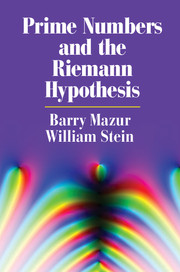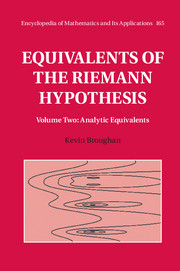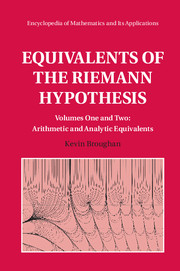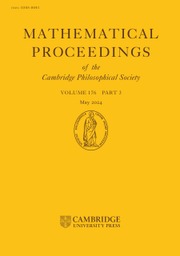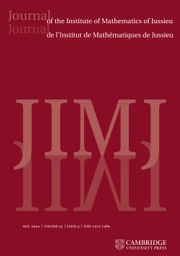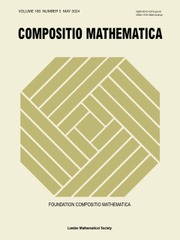Prime Numbers and the Riemann Hypothesis
AUD$41.95 inc GST
- Authors:
- Barry Mazur, Harvard University, Massachusetts
- William Stein, University of Washington
- Date Published: April 2016
- availability: Available
- format: Paperback
- isbn: 9781107499430
AUD$
41.95
inc GST
Paperback
Other available formats:
Hardback, eBook
Looking for an inspection copy?
Please email [email protected] to enquire about an inspection copy of this book
-
Prime numbers are beautiful, mysterious, and beguiling mathematical objects. The mathematician Bernhard Riemann made a celebrated conjecture about primes in 1859, the so-called Riemann hypothesis, which remains one of the most important unsolved problems in mathematics. Through the deep insights of the authors, this book introduces primes and explains the Riemann hypothesis. Students with a minimal mathematical background and scholars alike will enjoy this comprehensive discussion of primes. The first part of the book will inspire the curiosity of a general reader with an accessible explanation of the key ideas. The exposition of these ideas is generously illuminated by computational graphics that exhibit the key concepts and phenomena in enticing detail. Readers with more mathematical experience will then go deeper into the structure of primes and see how the Riemann hypothesis relates to Fourier analysis using the vocabulary of spectra. Readers with a strong mathematical background will be able to connect these ideas to historical formulations of the Riemann hypothesis.
Read more- Provides a concise but comprehensive narrative for students and scholars alike
- The text is broken into parts, thus providing greater accessibility
- Offers many mathematical illustrations
Awards
- Honourable Mention, 2017 PROSE Award for Mathematics
Reviews & endorsements
'This is an extraordinary book, really one of a kind. Written by two supreme experts, but aimed at the level of an undergraduate or curious amateur, it emphasizes the really powerful ideas, with the bare minimum of math notation and the maximum number of elegant and suggestive visuals. The authors explain why this legendary problem is so beautiful, why it is difficult, and why you should care.' Will Hearst, Hearst Corporation
See more reviews'This book is a soaring ride, starting from the simplest ideas and ending with one of the deepest unsolved problems of mathematics. Unlike in many popular math books puffed up with anecdotal material, the authors here treat the reader as seriously interested in prime numbers and build up the real math in four stages with compelling graphical demonstrations revealing in deeper and deeper ways the hidden music of the primes. If you have ever wondered why so many mathematicians are obsessed with primes, here's the real deal.' David Mumford, Brown University, Rhode Island
'This is a delightful little book, not quite like anything else that I am aware of … a splendid piece of work, informative and valuable. Undergraduate mathematics majors, and the faculty who teach them, should derive considerable benefit from looking at it.' Mark Hunacek, MAA Reviews
'This book is divided into four parts, and succeeds beautifully in giving both an overview for the general audience and a sense of the details needed to understand how quickly the number of primes grows. This is accomplished through a very clear exposition and numerous illuminating pictures.' Steven Joel Miller, MathSciNet
'Where popularizers of mathematics usually succumb either to a journalist's penchant for 'man bites dog' irony and spectacle or a schoolteacher's iron will to simplify away the terror, one might call the distinctive approach here 'take a lay reader to work'. Computers now provide mathematicians a laboratory, and the authors exploit this modern power to exhibit graphics, making the key equivalence a luminous phenomenon of experimental mathematics … for its clarity and the importance of its topic, this book deserves the same classic status as A Brief History of Time (CH, Jul'88). Summing Up: Essential. All readers.' D. V. Feldman, CHOICE
'Prime Numbers and the Riemann Hypothesis is an agile, unusual book written over a decade, one week per year; it can be considered a sort of collaborative work, in that each version was put online with the purpose of getting feedback.' Massimo Nespolo, Acta Crystallographica Section A: Foundations and Advances
'… a great gift for a curious student. Using the graphical methods found in calculus reform texts, this beautiful little book allows a patient reader with a good grasp of first-year calculus to explore the most famous unsolved problem in mathematics, the so-called Riemann Hypothesis, and to understand why it points to as yet undiscovered regularities in the distribution of prime numbers.' Donal O'Shea, The Herald Tribune
'The book under review succeeds handsomely in making the case for the Riemann Hypothesis to a wide audience … Beginning with the definition of prime numbers, the authors weave their way through concrete and picturesque presentations of elementary techniques and descriptions of unsolved problems connected with the primes. They provide many insightful footnotes, concrete and illuminating figures, pointers to arXiv pages for added information, and a rich set of endnotes that contain further descriptions and details with varying levels of sophistication. After 23 short sections (a few pages each) they have arrived at a formulation of the Riemann Hypothesis in terms of counting primes up to a given size. By this point in their masterful and compelling presentation, the Hypothesis appears to be completely natural and inevitable … I have no doubt that many newcomers to the subject who have read to the end of the book will be eager to learn more and will be drawn into this fertile playground.' Peter Sarnak, Bulletin of the AMS
'I really recommend this book if you want to get a feeling for the Riemann hypothesis without sinking into technicalities.' John Baez, The n-Category Café (http://golem.ph.utexas.edu/category)
Customer reviews
Not yet reviewed
Be the first to review
Review was not posted due to profanity
×Product details
- Date Published: April 2016
- format: Paperback
- isbn: 9781107499430
- length: 150 pages
- dimensions: 229 x 153 x 8 mm
- weight: 0.26kg
- contains: 110 b/w illus. 132 colour illus.
- availability: Available
Table of Contents
1. Thoughts about numbers
2. What are prime numbers?
3. 'Named' prime numbers
4. Sieves
5. Questions about primes
6. Further questions about primes
7. How many primes are there?
8. Prime numbers viewed from a distance
9. Pure and applied mathematics
10. A probabilistic 'first' guess
11. What is a 'good approximation'?
12. Square root error and random walks
13. What is Riemann's hypothesis?
14. The mystery moves to the error term
15. Césaro smoothing
16. A view of Li(X) - π(X)
17. The prime number theorem
18. The staircase of primes
19. Tinkering with the staircase of primes
20. Computer music files and prime numbers
21. The word 'spectrum'
22. Spectra and trigonometric sums
23. The spectrum and the staircase of primes
24. To our readers of part I
25. Slopes and graphs that have no slopes
26. Distributions
27. Fourier transforms: second visit
28. Fourier transform of delta
29. Trigonometric series
30. A sneak preview
31. On losing no information
32. Going from the primes to the Riemann spectrum
33. How many θi's are there?
34. Further questions about the Riemann spectrum
35. Going from the Riemann spectrum to the primes
36. Building π(X) knowing the spectrum
37. As Riemann envisioned it
38. Companions to the zeta function.-
General Resources
Find resources associated with this title
Type Name Unlocked * Format Size Showing of
This title is supported by one or more locked resources. Access to locked resources is granted exclusively by Cambridge University Press to lecturers whose faculty status has been verified. To gain access to locked resources, lecturers should sign in to or register for a Cambridge user account.
Please use locked resources responsibly and exercise your professional discretion when choosing how you share these materials with your students. Other lecturers may wish to use locked resources for assessment purposes and their usefulness is undermined when the source files (for example, solution manuals or test banks) are shared online or via social networks.
Supplementary resources are subject to copyright. Lecturers are permitted to view, print or download these resources for use in their teaching, but may not change them or use them for commercial gain.
If you are having problems accessing these resources please contact [email protected].
Sorry, this resource is locked
Please register or sign in to request access. If you are having problems accessing these resources please email [email protected]
Register Sign in» Proceed
You are now leaving the Cambridge University Press website. Your eBook purchase and download will be completed by our partner www.ebooks.com. Please see the permission section of the www.ebooks.com catalogue page for details of the print & copy limits on our eBooks.
Continue ×Are you sure you want to delete your account?
This cannot be undone.
Thank you for your feedback which will help us improve our service.
If you requested a response, we will make sure to get back to you shortly.
×
